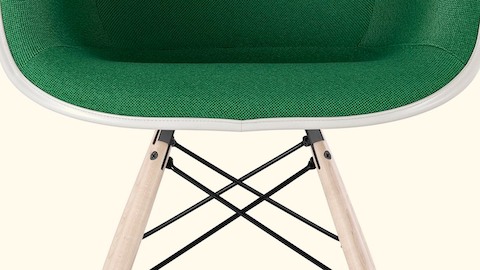“Innovate as a last resort,” Charles Eames famously said. “More horrors are done in the name of innovation than any other.” The designer and his wife and collaborator Ray notoriously favored evolution over revolution, iteration over innovation. Their staggering track record of successful designs is due largely to the fact that they perpetually improved the designs and technologies of projects past.
This trajectory began when the duo moved to Los Angeles in 1942 and began experimenting with ways to mass-produce molded plywood furniture with complex curves. When they learned that the metal splints in use by the Navy Medical Corps during World War II were causing additional injuries to soldiers, Charles and Ray dedicated nights and weekends to solving the problem. Soon enough, they’d molded a biomorphic splint out of plywood—lightweight, inexpensive, and easily transportable.
They then iterated on the contraption they’d invented to create the splint—the Kazam! Machine—producing a more efficient version. Using heat and pressure to mold plywood into separate panels for a chair back and a seat, they created what would go on to be called the “best design of the century” by Time magazine. The Eames Molded Plywood Chair inspired the Eames Office to use the same process to execute a series of experiments that rendered tables, a lounge chair, children’s furniture and toys, and folding screens.
“Although Charles eschewed innovation for its own sake, his obsession with building on previous design elements and prior technical accomplishments to achieve a new level of refinement very often led, in fact, to design innovations,” says Dr. Robert Blaich, former Vice President of Design and Development at Herman Miller who worked closely with the Eameses over the course of his career at Herman Miller. “He preferred to define these incremental improvements as quests for quality.”
The 1962 design for Tandem Sling Seating—whose iconic form is still found in airports around the globe—epitomizes Charles and Ray’s approach and, like many things Eames, stemmed from a previous project: the Aluminum Group Chair.
The Tandem story starts in 1958, when architect and friend Eero Saarinen turned to the Eames Office with a request for durable, comfortable furniture for his new Dulles Airport in Washington D.C. Simultaneously, C.F. Murphy Associates—an architecture firm that was in the process of constructing two new buildings at Chicago’s O’Hare airport—contacted Blaich with a near-identical request: durable, aesthetically pleasing, wear-resistant, and easy-to-maintain seating.
The Eameses had a scant year to design, tool, produce, and install the furniture—a feat largely made possible by the fact that they leaned on much of what they learned while working on the Aluminum Group, evolving the technology and design to fit the new problem. The Eameses’ ties to Saarinen ran deep: Charles previously collaborated with him on the 1940 Organic Chair for the Museum of Modern Art’s “Organic Design in Home Furnishings” competition. And the Aluminum Group itself was born as durable outdoor seating for the J. Irwin Miller House, the modernist villa that Saarinen designed in Columbus, Indiana, for the banking magnate.
The trick with Tandem was taking what the Eameses had learned making individual chairs and ottomans and honing it to become a seating system. Tandem’s sling system consisted of single or double back-to-back rows of two to ten seats made of heat-sealed Naugahyde held between polished aluminum castings and connected to a continuous steel beam. The interchangeable seat and back pads were constructed with the same heat-sealing process developed for the Aluminum Group. “By the time Herman Miller was ready to produce these things, the supplier network was pretty much created,” Blaich points out.
Charles and Ray’s iterative quests for quality were powered by no greater driving force than the desire to solve problems. As Charles once said in a University of Southern California Lecture on Design, “If it is the function of design to solve the evolving problems of man (and I repeat “evolving” because man’s problems are constantly changing), then the designer’s first concern must be the true need.”
Anyone who has walked through an airport terminal has undoubtedly spotted a benighted traveler sitting on the floor simply to charge their phone. Herman Miller’s own research shows that 88% of available airport outlets go unused because of poor placement. Today, Herman Miller and the Eames Office are carrying on in the spirit of Eamesian evolution by revising Tandem Sling Seating to offer charging stations placed beneath the seats.
“Charles was always very savvy in terms of technology, and if today’s problem of people needing to charge their devices would have been the problem back then, he would have jumped on it, and we would’ve solved for it one way or another,” Blaich says.
Evolutions like this one are made possible by the partnership between Herman Miller and the Eames Office. “That relationship is collaborative,” says Eames Demetrios, director of the Eames Office and grandson of the Eameses. “It’s a dialogue. A huge part of the design process for Charles and Ray involved making things better, so the Eames Office and Herman Miller work together and inherently remain concerned about making improvements on the products as they become necessary.”
Such was the case when, in the early ‘90s, Herman Miller realized that the fiberglass used on the Shell Chair wasn’t the most environmentally friendly material. They ceased production and later reintroduced the chair in 2000 in 100% recyclable polypropylene.
“We really live by this notion that the role of the designer is that of a good host, anticipating the needs of the guest. With airport seating in the age of technology, we really have a new kind of guest,” Demetrios says. “That’s what’s inspiring about working on projects like this. It’s not like there’s something wrong with Tandem seating. The need has evolved, and so we evolve the furniture.”




